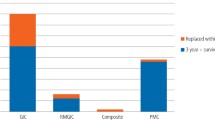Key Points
-
Under specialist practice conditions, resin-modified glass-ionomer cement (RMGIC) restorations are shown to be highly successful.
-
Class II RMGICs were as successful as preformed metal crowns.
-
Emphasis is placed upon only placing intra-coronal restorations in minimal cavities, preformed crowns being used where the decay process is more advanced.
-
High usage of rubber dam reflects the authors' firmly held belief that not only does it provide moisture control, but aids considerably in behaviour management.
Abstract
Aims To prospectively report on the survival of resin-modified glass ionomer cement (RMGIC), photac-fil and pre-formed stainless steel crown (SSC) restorations in primary molar teeth placed over a seven-year period in a specialist paediatric dental practice under private contract of remuneration.
Method All primary molar restorations placed by a specialist paediatric dentist over a seven-year period were reviewed and the outcome results recorded. Data were recorded at review visits until June 30, 2003. Data recorded included Class I restorations, Class II restorations and SSC. The Class II cavities were either mesial or distal, with or without buccal/palatal extensions. If both proximal surfaces were decayed or if after cavity preparation the resultant outline form was significantly larger than the minimal classical form, RMGIC was not used; an SSC was placed instead. Stainless steel crown preparation followed conventional guidelines. The crowns were cemented with reinforced zinc oxide and eugenol (Kalzinol). The status was recorded as satisfactory restoration, tooth exfoliated, tooth extracted for orthodontic reasons with the date of extraction, or needing replacement. If replaced then the reason for replacement was also recorded.
Results A total of 544 Class I RMGICs, 962 Class II RMGICs, and 1,010 SSCs were placed. At the last review of each restoration, 98.3% of Class I, 97.3% of Class II RMGICs and 97.0% of SSCs were either satisfactory or withdrawn intact.
Conclusion Under the conditions of private specialist practice-based study SSCs continued to prove very successful for the restoration of larger cavities and for pulp-treated primary molar teeth. For the smaller cavities RMGIC were also very successful.
Similar content being viewed by others
Log in or create a free account to read this content
Gain free access to this article, as well as selected content from this journal and more on nature.com
or
References
Murray J . Prevalence of dental caries: retrospect and prospect. Dent Update 1998; 25: 374–378.
Roberts JF, Sherriff M . The fate and survival of amalgam and preformed crown restorations placed in a paediatric dental practice. Br Dent J 1990; 169: 237–244.
Randall RC, Vrijhoef MMA . Efficacy of preformed metal crowns vs. amalgam restorations in primary molars. J Am Dent Assoc 2000; 131: 337–343.
Curzon MEJ, Roberts JF, Kennedy D . Kennedy's paediatric operative dentistry. 4th ed. Oxford: Butterworth-Heinemann, 1996. pp 79–87, 114–127.
Black GV . Operative Dentistry. Vol 2 - treatment of caries. Chicago: Medico-Dental Pub. Co, 1936. pp 78–112.
Osborne JW, Albino JE . Psychological and medical effects of mercury intake from dental amalgam: a status report from the American Journal of Dentistry. Am J Dent 1999; 12: 151–156.
Peretz B, Ram D . Restorative material for children's teeth: preferences of parents and children. J Dent Child 2002; 69: 243–248.
Nelson GV, Osborne JW, Gale EN, Norman RD, Phillips RW . A three year clinical evaluation of composite resin and a high copper amalgam in posterior primary teeth. J Dent Child 1980; 47: 414–418.
Oldenburg TR, Vann WF, Dilley DC . Composite restorations for primary molars: results after four years. Pediatr Dent 1987; 9: 136–143.
Vann WF, Burkmeier WW, Mahler DB . Assessing composite resin wear in primary molars: four-year clinical findings. J Dent Res 1988; 67: 876–879.
Kilpatrick NM . Durability of restorations in primary molars. J Dent 1993; 21: 67–73.
Papathanassiou AG, Curzon MEJ, Fairpo CG . The influence of restorative material on the survival rate of restorations in primary molars. Pediatric Dent 1994; 16: 282–288.
Wilson AD, Kent BE . A new translucent cement for dentistry. The glass ionomer cement. Br Dent J 1972; 132: 133–135.
Mjor IA, Moorhead JE . Selection of restorative materials; reasons for replacement and longevity of restorations in Florida. J Am Coll Dent 1998; 45: 27–33.
de Araujo FB, Garcia-Godoy F, Cury JA, Conceicao EN . Fluoride release from fluoride-containing materials. Operative Dent 1996; 21: 185–190.
Mount GJ . Clinical placement of modern glass-ionomer cements. Quintessence Int 1993; 2: 99–107.
Mount GJ . Glass ionomer cements and future research. Am J Dent 1994; 7: 286–292.
Combe EC, Burke FJJ, Douglas WH . Dental biomaterials. London: Kluwer, Academic Publishers, 1999. pp 221–231.
Mitra SB, Kedrowski BL . Long-term mechanical properties of glass ionomers. Dent Materials 1994; 10: 78–82.
Douglas WH, Lin CP . Strength of the new systems. In Hunt P R. (ed) The next generation (Proceedings of the second International symposium on glass ionomers). Philadelphia: International Symposia in Dentistry, PC, 1994. 209–216.
Croll TP, Bar-Zion Y, Segura A, Donly KJ . Clinical performance of resin-modified glass ionomer restorations in primary teeth; a retrospective evaluation. J Am Dent Assoc 2001; 132: 1110–1116.
Hübel S, Mejàre I . Conventional versus resin-modified glass ionomer cement for Class 2 restorations in primary molars. A three year clinical study. Int J Paed Dent 2003; 13: 2–8.
Mjor IA, Dahl JE, Moorhead JE . Placement and replacement of restorations in primary teeth. Acta Odontol Scand 2002; 60: 25–28.
Donly KJ, Segura A, Kanellis M, Erickson RL . Clinical performance and caries inhibition of resin-modified glass ionomer cement and amalgam restorations. J Am Dent Assoc 1999; 130: 1459–1466.
Agresti A . An introduction to categorical data analysis. Wiley Series in Probability and Statistics. Chichester: Wiley-Interscience.
Murray PE, About I, Lumley PJ, Franquin JC, Remusat M, Smith AJ . Cavity remaining thickness and pulpal activity. Am J Dent 2002; 15: 41–46.
Fusayama T . Two layers of carious dentine: diagnosis and treatment. Operative Dent 1979; 4: 63–70.
Finn SB . Clinical Pedodontics. 2nd ed. London: Saunders, 1962.
Shovelton DJ . Studies of dentine and pulp in deep caries. Int Dent J 1970; 20: 283–296.
Bjorndale L, Larsen T, Thylstrup A . A clinical and microbiological study of deep carious lesions during stepwise excavation using long treatment intervals. Caries Res 1997; 31: 411–417.
Mertz-Fairhurst EJ, Curtis TW, Ergle JW, Rueggeberg FA, Adair SM . Ultra conservative and cariostatic sealed restorations; results at year ten. J Am Dent Assoc 1998; 129: 55–66.
Kan KC, Messer LB . Variability in cytotoxicity and fluoride release of resin-modified glass-ionomer cements. J Dent Res 1997; 76: 1502–1507.
Sidhu SK, Sherriff M, Watson TF . The effects of maturity and dehydration shrinkage on resin-modified glass-ionomer restorations. J Dent Res 1997; 76: 1495–1501.
Ribeiro APG, Serra MC et al. Effectiveness of surface protection for resin-modified glass-ionomer materials. Quintessence Int 1999; 30: 427–431.
Chuang SF, Jin YT, Wong TY . Effect of various surface protections on the margin microleakage of resin-modified glass ionomer cements. J Prosthet Dent 2001; 86: 309–314.
Mazzaoui SA, Burrow MF, Tyas MJ . Fluoride release from glass ionomer cements and resin composites coated with a dentin adhesive. Dent Materials 2000; 16: 166–171.
Author information
Authors and Affiliations
Corresponding author
Additional information
Refereed paper
Rights and permissions
About this article
Cite this article
Roberts, J., Attari, N. & Sherriff, M. The survival of resin modified glass ionomer and stainless steel crown restorations in primary molars, placed in a specialist paediatric dental practice. Br Dent J 198, 427–431 (2005). https://doi.org/10.1038/sj.bdj.4812197
Received:
Accepted:
Published:
Issue date:
DOI: https://doi.org/10.1038/sj.bdj.4812197
This article is cited by
-
The In-Vitro Effect of Silver and Zinc Oxide Nanoparticles on Fluoride Release and Microhardness of a Resin-Modified Glass Ionomer Cement
Journal of Inorganic and Organometallic Polymers and Materials (2023)
-
A 24-month retrospective study of preformed metal crowns: the Hall technique versus the conventional preparation method
European Archives of Paediatric Dentistry (2021)
-
Management of carious primary molars within the community dental setting in Wales: a retrospective observational study
British Dental Journal (2019)
-
A 2-year clinical evaluation of stainless steel crowns and composite resin restorations in primary molars under general anaesthesia in China's Guangdong province
British Dental Journal (2018)
-
Clinical assessment of class II resin-based composites versus preformed metal crowns performed on primary molars in patients at high risk of caries
European Archives of Paediatric Dentistry (2018)



